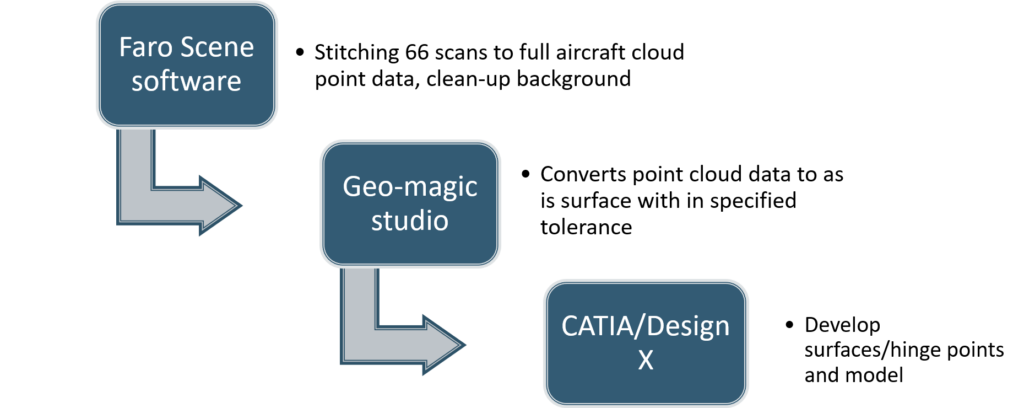Unlocking Seamless Integration: Empowering Aircraft Design through 3D Modeling

Cloud Point Image – 46 billion points
A 3D model of an aircraft can be highly beneficial for integration studies in several ways. Here are some key purposes and benefits of using a 3D model for aircraft integration studies:
1. Visualization: A 3D model provides a realistic visual representation of the aircraft, allowing engineers and designers to examine various aspects of its integration with other systems or components. This visual representation helps in understanding the spatial relationships and potential interferences between different elements.
2. System Integration Analysis: Integration studies involve analyzing the compatibility and interactions between various systems within an aircraft. By creating a 3D model, engineers can virtually integrate different systems, such as avionics, electrical, hydraulic, fuel, and environmental control systems, to identify potential clashes or conflicts early in the design process. This analysis helps in optimizing system layouts and reducing the risk of errors during physical integration.
3. Interference Detection: The 3D model can be used to simulate the installation of different components, subsystems, or modifications to the aircraft. It allows engineers to detect potential interferences or conflicts between the aircraft structure, systems, and new components. By identifying such interferences early, costly rework or redesign can be avoided, saving time and resources.
4. Ergonomics and Human Factors: A 3D model aids in evaluating the human-machine interface and ergonomics aspects of an aircraft. It enables designers to assess the placement of controls, displays, seating arrangements, and accessibility of various systems for maintenance. By considering human factors early in the design phase, improvements can be made to enhance pilot and maintenance crew efficiency, comfort, and safety.
5. Performance Analysis: Integration studies can involve assessing the impact of integrating new systems or components on the aircraft’s performance parameters, such as weight, balance, center of gravity, drag, and aerodynamic characteristics. A 3D model enables engineers to simulate these changes and analyze their effects on the aircraft’s performance. This analysis helps in making informed decisions and optimizing the integration process.
6. Collaboration and Communication: A 3D model provides a common visual reference for cross-functional teams working on aircraft integration projects. It enhances communication among engineers, designers, manufacturers, and other stakeholders by facilitating a shared understanding of the integration requirements and design constraints. This collaboration leads to better integration outcomes and reduces the chances of misinterpretation or errors.
Overall, using a 3D model for aircraft integration studies improves design efficiency, reduces errors, and enables a comprehensive analysis of integration aspects, resulting in a better-integrated aircraft with optimized performance, safety, and functionality.

Methodology:
- Scan 1 million points per second over 300×360 view
- Capture reflected pulses by a sensor
- Calculate distance by return time and wave length difference
- Sphere targets and check board flags set on the aircraft and its surroundings, acting as references to stitch the images
- Convert raw data in to surface and then model.
Steps for 3D Model Generation

A 3D model is an essential component for conducting Computational Fluid Dynamics (CFD) analysis by BHSPL. CFD is a numerical simulation technique used to study fluid flow, heat transfer, and other related phenomena.
The accuracy of a 3D model depends on various factors, including the methodology used to create the model, the quality of the input data, and the level of detail required for the specific application. Here are some considerations related to the accuracy of 3D models:
1. Data Source: The accuracy of a 3D model heavily relies on the quality and accuracy of the data used to create it. BHSPL generates 3D model based on precise measurements using laser scanning which provides high accuracy compared to models created from less accurate or approximate data sources.
2. Modeling Technique: The modeling technique employed to create the 3D model also affects its accuracy. Approx 46 billion points cloud image is created.
3. Level of Detail: The level of detail captured in the 3D model plays a role in its accuracy. Higher levels of detail generally require more precise measurements and can provide a more accurate representation of the object or system.
4. Geometric Complexity: The geometric complexity of the object being modeled can affect accuracy. Aircrafts are highly complex as compared to organic shapes and thu require more data points to capture the intricate details accurately.
5. Software and Tools: The software and tools used for creating and manipulating the 3D model can influence its accuracy. BHSPL uses Advanced CAD software and specialized modeling tools to offer more precision and control, allowing for accurate modeling operations and measurements.
6. Validation and Verification: To assess the accuracy of a 3D model, it is important to compare it with real-world data or reference sources. This involves validation and verification processes. BHSPL validates this using (a) Geometrical Accuracy by comparing physical measurements and also  by (b) Aerodynamic Validation by conducting simulations and experiments, or benchmarking against established standards or reference models such as known Cl vs Alpha curve.
by (b) Aerodynamic Validation by conducting simulations and experiments, or benchmarking against established standards or reference models such as known Cl vs Alpha curve.
It’s worth noting that achieving absolute accuracy in a 3D model is a challenging task due to various limitations, such as measurement errors, data limitations, or simplifications made during the modeling process. However, by employing sound modeling techniques, utilizing accurate data sources, and validating the model against real-world measurements, 3D models generated by BHSPL provide a reliable representation of the aircrafts and stores for most practical applications and integration studies.
3D Model Generation Tools & Process


